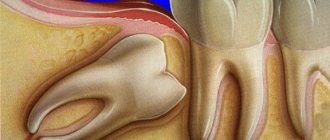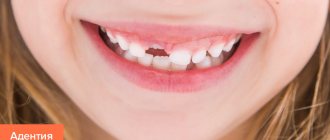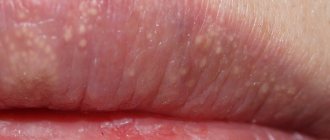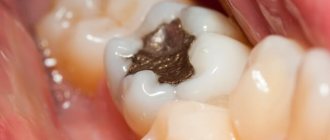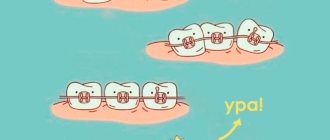In 6-10 year old children, baby teeth often fall out - a harbinger of the appearance of permanent teeth in their place. This fact should not cause any particular concern. However, there are cases when real teeth begin to loosen on their own. This is a signal that you need to consult a doctor without wasting time before the child’s health condition becomes dangerous. Loosening of baby teeth is a sure sign of a malfunction in the immune system.
Loosening of permanent teeth is a sign of both emerging diseases in the oral cavity and sudden problems with internal organs. The most common manifestations are:
- Periodontitis;
- Inflammation of the gums;
- Caries;
- Generalized metabolic disorders;
- Injuries.
If you find that your child has one or more molars that are loose, contact your dentist immediately. In some cases, the tooth root may become loose due to not entirely successful heredity - the root of the new tooth does not grow well into the jaw. It is necessary to check whether the parents of this child had such cases.
Periodontitis
This disease manifests itself at the age of 9 years - on average in 4% of children. When it occurs, the tissues surrounding the tooth become inflamed, and it begins to wobble. The basis of this process is the loss of properties. Inherent in tissues that have not yet fully matured. Here lies the main reason why teeth become loose and fall out.
To exclude such an unfavorable scenario, timely and proper teeth cleaning is needed. In childhood and adolescence, increased load on the same teeth (on the one hand), or the absence of products elastic enough for chewing, which allow, like a kind of simulator, to train growing teeth, is unacceptable. After all, what is trained during growth is what develops comprehensively.
If there is no tooth, but the others are loose. What should I do?
In this case, we can use removable dentures made from individual impressions. The missing tooth will be covered with an artificial crown.
Pros:
- a removable denture will preserve diction;
- restore the child’s chewing, bite and self-esteem;
- getting used to it will happen very quickly.
The choice of design and material depends on the specific situation. For some injuries, this is the only possible option while the healing process is underway.
Caries
Caries in childhood and adolescence develops much more rapidly than in adults. With it, the enamel is rapidly affected first, then the carious cavity penetrates the dentin and reaches the pulp. The last stage can lead to pulpitis and the need for drilling of the dental canal. The tooth enamel itself in children is immature - it is the most vulnerable, that is, it does not resist caries damage as actively as it does in adults. The maturation of tooth enamel continues for up to several years; it is necessary to brush your teeth twice a day, as doctors advise, in order to prevent the parasitic process.
Caries also manifests itself from the inside or from below - it is not the enamel of the crown or even the neck of the tooth that is affected, but the root, or the underlying structures begin to collapse. You can guess this by the fact that the tooth suddenly began to loosen.
What to do
If your front tooth begins to loosen for no apparent reason, you should clearly understand that inaction can lead to its loss. Initially, it is necessary to identify the cause of the disease in order to take the necessary measures to eliminate it. But it is almost impossible to independently identify the cause and make a correct diagnosis, so it is extremely important to seek the help of a specialist. Quite often, loose teeth are a consequence of bad habits, such as drinking alcohol and smoking. There are also hereditary causes of this process. People with malocclusion often have loose front teeth. In such situations, treatment should be carried out by a qualified orthodontist.
General diseases of the body
Children's teeth can also become loose due to systemic diseases. They are most often based on a violation of the blood flow of individual tissues adjacent to the teeth, or metabolic disorders. These include psoriasis, diabetes mellitus and diabetes insipidus, thyroid pathologies, congenital connective tissue disorders and several other diseases.
All these destabilizing factors lead to obstruction of blood flow through the capillaries in the body. The gums and pulp in the tooth are rich in microcapillaries, through which blood delivers oxygen and nutrients to the teeth, and removes waste products and excess carbon dioxide. If these processes are untimely, degenerative phenomena occur in which tissues starve, as a result, their growth and renewal stop, and their accelerated wear and degradation occurs. This causes the weakened tooth (or several teeth) to wobble and may fall out.
The permanent tooth is loose. What is the reason?
In most cases, excessively mobile teeth in children are a sign of injury, or a general poor condition of the body and a lack of microelements in the diet. It is important to show the child to a specialist in a timely manner and carry out treatment in order to stop the process at the very beginning.
What could cause the mobility?
- Bruises, unfortunate falls during games and sports. Newly erupted permanent teeth are very fragile. They have a thin layer of enamel and dentin, but a large nerve. Immature incisors, canines and molars are much easier to break than mature teeth. How to react and what to do if a child has a tooth injury, read here.
- Inflammation of oral tissues due to poor hygiene, chronic gingivitis, stomatitis, advanced caries and other diseases. Decreased immunity also serves as a factor in the appearance of infection of the mucous membrane and the gradual loosening of the dentition.
- Consequences of orthodontic treatment. Braces put pressure on your teeth and move them into new places. Therefore, immediately after removing the system, the dentition tends to return to its original position. To stop movement and prevent regression, the patient must wear retainers. If for various reasons the child refuses to do this, contact an orthodontist to undergo an examination and prescribe the correct treatment.
Injuries
Many children find it impossible to sit still. And some of them sometimes fall. If the injury occurs in the vicinity of the jaws, the teeth may also suffer. There are often cases where a child knocked out one or even two or three teeth during a fall. But tooth fractures are not always open - cracks and root fractures can also occur - the tooth tilts to the side, and accordingly, it immediately begins to wobble.
Dental injuries also appear when a child suffers from bruxism (grinding his teeth in his sleep), or tried to chew, for example, a candy that was too hard, or, for example, got a stone in the cereal from which the porridge was cooked.
Stages
There are several stages of tooth loosening, and almost anyone can experience this phenomenon.
- Initial. Gum bleeding occurs when brushing teeth, itching and swelling of the gums occurs, and there is an unpleasant odor from the mouth.
- At the next stage, discomfort when chewing food is added to the listed symptoms. The teeth begin to loosen even with a slight touch.
- If there is no treatment, then the process of destruction of the periosteal tissue begins and part of the root is exposed.
Treatment
When a child complains of looseness and pain in one or more molars, urgently visit the dentist with him. It is the dentist who will decide whether it is possible for a child not to lose a loose tooth. The doctor will take a number of measures to save the problematic tooth, which will avoid its loss and unpleasant consequences in the future. Of course, the tooth can later be replaced “from scratch” (along with a pin) - but it is better to try to preserve the original one.
When the cause of tooth loss is periodontitis or gingivitis, it is necessary to urgently clean the teeth of plaque, as well as prevent the development of inflammation that has already begun. It is possible that the teeth are splinted - this will stop their ongoing loosening.
In the event of a tooth injury, the question is raised about the possibility of saving it. When the damage is small, it is possible to preserve all intact dental tissues - they will help facilitate the process of prosthetics, becoming the “foundation” for a renewed tooth. If caries has developed, after a thorough examination, an attempt is made to save the molar. When the damage is too great, the tooth is simply removed to prevent it from rotting and damage to internal organs due to infection in the blood. If the carious cavity is small, the tooth is filled - nerves and blood vessels are removed from the pulp, disinfected with medications, and then dental cement is injected - an adhesive base that, after hardening, resembles hard dental tissue; In turn, a seal is installed on it.
If no visible damage to the teeth is found, the child undergoes a comprehensive medical examination. If any diseases are detected, he undergoes timely treatment.
Splinting teeth in children after injury
If your adventures result in dental injury, don’t be upset. Our doctors will carefully examine the damaged groups, carry out the necessary restoration of injured teeth, and also perform splinting and strengthening.
It is absolutely safe and aesthetically pleasing. A special orthodontic fiberglass or aramid thread is applied to the outer side of the teeth, which will unite several units into a stable chain.
In the early stages, this approach will completely eliminate mobility and will in no way prevent the little patient from leading a full life.
Splinting can be temporary or permanent, depending on the situation.
Pros:
- the ability to preserve loose teeth without the risk of premature atrophy of bone tissue;
- no need to grind crowns or remove pulp;
- an even distribution of the load between healthy and injured teeth is achieved;
- ease of care.
View prices for splinting teeth in children
Prevention
Taking care of your teeth is preserving the attractiveness of your smile, which is the calling card of both a child and, subsequently, an adult who sets important goals for himself. This means that taking care of your teeth should be timely, and it is better to get used to this right away in childhood. Parents will ensure that the child carries out high-quality sanitation of the oral cavity and teeth every day, and twice a year he needs to visit the dentist. Equally important is a balanced diet. If problems do affect at least one tooth, do not ignore them: you are responsible for the health of your child.
Pregnancy
During pregnancy, hormonal changes occur in a woman's body, which significantly affect the deterioration of blood supply to the mucous membranes. The child takes away the mother's calcium supply, which significantly worsens the condition of the mother's teeth. Also, calcium leaching occurs during toxicosis. As a result of these processes, the gums begin to bleed and become inflamed, periodontal pockets form where food remains accumulate, and teeth can begin to wobble. In order to strengthen and restore the oral cavity, expectant mothers should visit a dental clinic. The specialist will prescribe a set of preventive and therapeutic measures that will strengthen loose teeth. Such events include:
- professional dental hygiene;
- recommendations for a proper diet, which includes the mandatory consumption of foods containing large amounts of calcium (fermented milk products, vegetables, fruits, fish and meat);
- prescribing additional intake of mineral and vitamin complexes;
- the use of additional oral care products, such as rinses, flosses, etc.
What to do when a child’s molars are loose
Molars in a child’s bite are all the replaced units, as well as the outer chewing ones: “sixes”, “sevens”, “eights”. Due to the extensive root system, these teeth are firmly fixed in the dentoalveolar rows, but sometimes they begin to wobble.
Doctors distinguish between natural physiological mobility, which occurs when loads are redistributed by periodontal tissues, and pathological mobility, visible to the patient. The reasons for the loosening of radical units can be:
- Injuries – a strong blow to the jaw can easily cause dislocation or fracture of a tooth and damage adjacent soft tissues.
- Inflammation of the gums and periodontal tissues - due to changes in bite, poor hygiene and disruption of the microflora in the oral cavity. The development of gingivitis will worsen the situation, since if left untreated, young patients develop periodontitis - inflammation that leads to loosening and loss of teeth.
- Caries - developed from below at the neck of the root. It is especially common in remote units - “fives”, “sixes”.
- Incorrect bite – leads to uneven distribution of the load during chewing and loosening of individual teeth due to overload.
- Bruxism is a strong clenching of the jaws and grinding that often causes the incisors to wobble.
- Genetic diseases of the body - metabolic disorders and microcirculation in tissues harm periodontal health, which causes excessive mobility of healthy teeth.
Tottering root units often require complex solutions. The examination begins with a consultation with a pediatric dentist, who determines the main cause of molar mobility and draws up a treatment algorithm. Sometimes it is enough to cure caries or strengthen the enamel, but in other cases prosthetics, splinting or another solution may be required.
Dolotova Marina
“Young patients are very active, so injuries to permanent incisors or canines are not uncommon. Athletes especially often suffer from this problem. There is no need to be afraid of a moving tooth. Modern splinting techniques securely fix the tooth in place, restoring a rigid connection with the tissues. True, you will have to refrain from training and solid food. But this is temporary!
Any mobility of the dental crown, accompanied by pain, discomfort or poor health, is a reason to make an appointment at a children’s dental clinic. This will be either the first step towards peace of mind for parents and the child, or the beginning of professional treatment and saving the tooth.
To pull out or not
Units are removed according to indications. They can be absolute and relative.
- Severe carious destruction, when the tooth has darkened, therapy is impossible.
- The eruption of the root organs precedes the loss of mammary units. In such a situation, the tooth needs to be pulled out.
- Multiple severe fistulas on the gingival tissues.
- Large root cysts.
- Pulpitis in severe form.
- Periodontitis, other dental diseases.
If a loose chewing organ does not fall out on its own and causes discomfort to the baby, it is usually removed, as it can lead to gum inflammation. Anesthesia is not used in this situation. Some babies push their teeth out with their tongue. Such units come off when biting into hard foods. For minor bleeding, apply a cotton swab, which must be moistened with a disinfectant. You should remove a baby tooth that is hanging by a thread so that it does not fall out at night or block your breathing.
- First you need to cool the gum with a piece of ice.
- Then you need to grab the unit with a paper napkin and quickly turn it around its axis.
- A sterile gauze pad should be applied to the wound site; a clean handkerchief will do.
Pulling out a baby tooth is not difficult. After the procedure, it is useful to rinse your mouth with chamomile decoction. It's a different matter when the little one cries and does not agree to open his mouth. You should not scold the child at the same time. You need to see a dentist. The doctor will help if:
- The root unit grows until the mammary organ prolapses; there is a fear that it will be crooked;
- Temporary incisors and molars fell out early;
- Many people in the family wore braces;
- The temperature has increased and lasts for 2-3 days;
- The tooth is loose, making it difficult to chew;
- The unit is broken, it hurts the tongue;
- Severe carious lesions;
- Diagnosed with periodontal disease or rickets, diabetes mellitus or anemia.
It happens that the chewing organs become loose, but do not fall out on their own. Most likely, there is excess calcium in the baby’s body. The quality of life of children depends on how quickly parents react.
Let's understand the concept of “indigenous”
In general, by the term “molar”, experts mean the outer chewing teeth or molars located on the upper and lower jaws. In another way, they are also called sixes, sevens and eights (wisdom teeth) in the permanent dentition or fours and fives in the milk teeth. They are intended mainly for coarse grinding and primary mechanical processing of food. They are the most stable and durable, have an extensive root system.
Teeth arrangement
But in everyday life, people who have little to do with medicine mean by “molars” all the permanent teeth that have erupted after the milk or temporary teeth have fallen out. Therefore, let's look at the problem from the right point of view - if a child has a loose molar, then we will talk specifically about the chewing teeth, regardless of whether they are in the primary or permanent dentition.
Important! It’s worth mentioning right away that, in general, it makes no difference which teeth are loose (molars, i.e. lateral or front), since the reasons for their mobility are completely identical. And sometimes they do not depend on the bite - milk or permanent. But there is a difference: the front teeth are more easily injured, while the side teeth more often suffer from carious lesions due to their inaccessibility and difficult hygiene. In any case, care, care, attention and treatment should be carried out for all elements of the child’s jaw system with equal diligence.
A 5-year-old child has loose baby teeth: what to do?
What to do if a child’s baby tooth is very loose?
The question is relevant for parents of children 5-6 years old. During this period, the bite begins to change, and the milk units acquire increased mobility. The process is natural, and in its normal course does not cause any inconvenience to the child. The period of spontaneous loss depends on many factors and takes from 3-4 days to a couple of months. Often, adults and children lose patience and try to remove a changing tooth on their own - by pulling it out with a thread, by hand, or by including obviously hard foods in the menu. Dentists do not advise overdoing it. Why you shouldn’t help change your bite when a 5.5-year-old child’s teeth are loose:
- The first milk teeth should be replaced on their own - in the absence of pathologies and normal growth of new teeth.
- Healthy primary teeth provide the correct environment in the mouth for growth and bite development.
- Baby teeth are gradually preparing for the eruption of molars - the roots must dissolve, and the new crown will prepare to emerge from the gums.
Interference with the natural process is fraught with dental problems - malocclusion, teeth growing in a “checkerboard” pattern. But these same problems are also possible with an unsupervised shift, so parents should monitor the child’s condition and, if problems arise, contact pediatric dentists.
Rodikova Tatyana
“Often parents themselves try to remove a loose baby tooth from their child. This can only be done if the baby is not afraid and the tooth itself is very mobile. Of course, we must not forget about sterility and cleanliness, otherwise the consequences of removal will take a long time to heal. But the best option is to entrust the procedure to a doctor. He will do it faster, more professionally, without pain and without scaring the child!”


